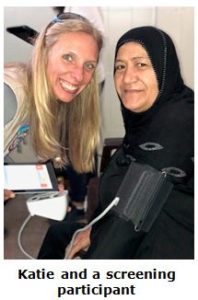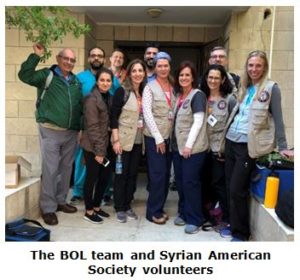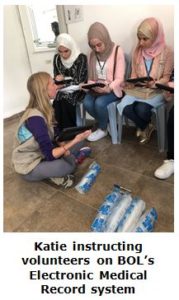Bridge of Life Up Close
A People’s Resilience: The Importance of Serving Syrian Refugees
 Before Bridge of Life (BOL)’s mission to Jordan in April 2018, I thought of the Syrian conflict as a distant global problem. I didn’t consider the individual story of each Syrian and I overlooked the fact that, given their circumstances, they far too often don’t have opportunities to represent themselves. The conflict isn’t given the same coverage it used to have – or maybe our ears are just going deaf to their continual crisis. After completing this mission, I felt a sense of responsibility to share some of what I learned and witnessed.
Before Bridge of Life (BOL)’s mission to Jordan in April 2018, I thought of the Syrian conflict as a distant global problem. I didn’t consider the individual story of each Syrian and I overlooked the fact that, given their circumstances, they far too often don’t have opportunities to represent themselves. The conflict isn’t given the same coverage it used to have – or maybe our ears are just going deaf to their continual crisis. After completing this mission, I felt a sense of responsibility to share some of what I learned and witnessed.
Like most people that BOL serves, the Syrian refugees that visited our mobile clinic live in extreme poverty. They often live together with dozens of other people in small apartments, shacks or tents. Hygiene is difficult – some don’t have running water or electricity. Zaatari, the main camp in Jordan, is in the desert where many plants or animals can’t even survive. But back in Syria, the refugees’ lives were much different.
Many of the patients we served were teachers, doctors, graphic designers, lawyers, engineers, and store owners. Some had homes, cars and businesses. Their children went to school and had ambitions to secure important jobs. Some people we screened already had in-depth knowledge about the chronic illnesses we were testing for. They would see their blood pressure reading, for example, and say, “Oh, that’s too high. It must be from the stress.” The consequences of the war came to life for our volunteer team – people fled Syria to save their families’ lives. They kissed the walls of their homes goodbye as they escaped to get their families to safety.
 The circumstances that our patients faced in Syria were beyond my comprehension. In 2010, what started as peaceful demonstrations ended in civil war. Homes and schools in the cities were bombed, and people often fled to the countryside where there was no food, water or electricity. Parents were afraid to send their children to school. It was commonplace for children to hear explosions and witness death.
The circumstances that our patients faced in Syria were beyond my comprehension. In 2010, what started as peaceful demonstrations ended in civil war. Homes and schools in the cities were bombed, and people often fled to the countryside where there was no food, water or electricity. Parents were afraid to send their children to school. It was commonplace for children to hear explosions and witness death.
We visited one organization called Souriyat Across Borders that serves amputee children impacted by the war. We treated people who the war had left with severe burns or crooked legs. Young or old, everyone seemed utterly exhausted.
We served one man who had to leave all his belongings when he came to Jordan. He didn’t even have time to take his shoes and arrived in Jordan wearing flip-flops. Today, he and his family are living in Irbid with nothing. One volunteer commented to the man on how difficult this time must be for his family. But the man responded, “I just thank God that we are okay.” The resilience we encountered from patients was  astounding! Still, countless other people I spoke to were separated from their families. One woman cried, “How can I start over when my daughter is still there?” Many patients shared photos of loved ones with us, and almost everyone had friends and family that died in the war. Sometimes people didn’t know if their loved ones were dead or incarcerated.
astounding! Still, countless other people I spoke to were separated from their families. One woman cried, “How can I start over when my daughter is still there?” Many patients shared photos of loved ones with us, and almost everyone had friends and family that died in the war. Sometimes people didn’t know if their loved ones were dead or incarcerated.
On the evening of our last day in clinic, our team (which included a group of Syrian doctors and medical students) went to a traditional Syrian restaurant for dinner. The restaurant had a live band that filled the room with Syrian music, perhaps some of the most beautiful music I’d ever heard. It didn’t take long for all the Syrians to join together in song and dance, and there was this overwhelming sense of belonging. It was truly a sublime moment.
After this trip, I no longer think of pity when I think of the Syrian refugees. Instead, I think of people leaving Syria in search for dignity and safety. And I think of courage, resilience and the will to thrive.